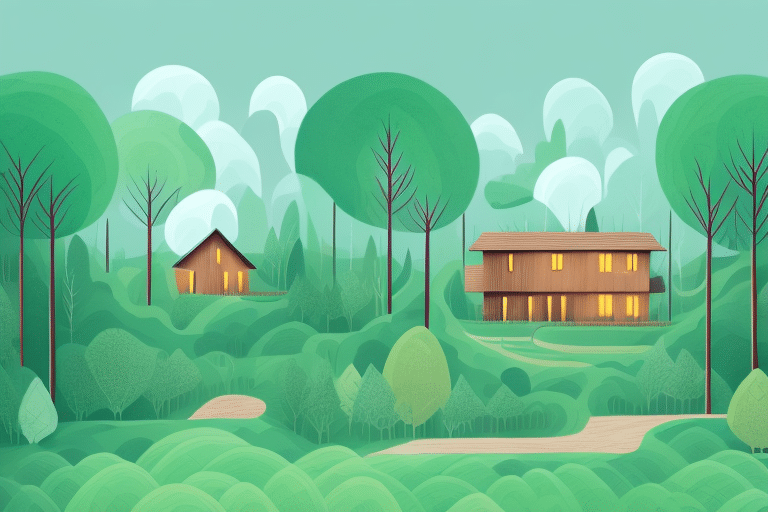Buying Home Insurance in Forest Communities

Protecting Your Paradise: A Comprehensive Guide to Buying Home Insurance in Forest Communities
Buying home insurance in forest communities and protecting your home is paramount in forest communities, where nature and tranquility abound. Forest homes come with unique risks and challenges that require specialized insurance coverage. This comprehensive guide will walk you through everything you need to buy home insurance in forest communities.
A Closer Look at Forest Homes: Unique Insurance Needs
Forest homes offer a picturesque setting but have specific risks and insurance needs. Due to their remote locations and dense vegetation, forest homes are more susceptible to wildfires, storm damage, and wildlife encounters. Understanding these unique risks is crucial when purchasing insurance for your forest home.
Regarding wildfires, forest homes face a higher risk than homes in urban or suburban areas. The dense vegetation surrounding forest homes fuels fires, making them more likely to spread quickly and cause extensive damage. As a result, insurance coverage for forest homes often includes provisions for rebuilding or repairing structures, replacing personal belongings, and providing temporary housing during a wildfire.
In addition to wildfires, forest homes are also vulnerable to storm damage. The dense tree cover in forested areas increases the chances of falling branches or trees during severe weather events. These falling objects can cause significant damage to the home’s structure and any vehicles or other property nearby. Insurance policies for forest homes typically include coverage for repairing or replacing damaged systems and any personal property affected by storm-related incidents.
Wildlife encounters are another unique risk that forest homeowners must consider regarding insurance coverage. Forested areas are home to various wildlife, including bears, deer, and smaller animals like raccoons or squirrels. While these encounters can be exciting and provide a sense of connection with nature, they can also damage property. Insurance policies for forest homes often include coverage for repairs or replacements in the event of wildlife-related incidents, such as a bear breaking into the house or a deer colliding with a vehicle.
When buying home insurance in forest communities, working with an insurance provider who understands the risks associated with these unique properties is essential. They can help assess the value of your home and belongings, determine the appropriate coverage limits, and provide guidance on additional options necessary for your specific location.
In conclusion, forest homes present a beautiful and serene living environment but come with risks and insurance needs. Understanding these risks and working with an insurance provider specializing in forest home coverage can help ensure you have the necessary protection. So, if you’re considering purchasing or already owning a forest home, please take the time to carefully evaluate your insurance options and ensure you have comprehensive coverage that addresses the unique needs of your property.
Fire Risks in Forest Areas: Navigating Insurance Coverage
Wildfires are a significant concern in forest communities. The destructive power of these infernos can ravage homes, destroy property, and cause irreparable damage to the natural environment. As a responsible homeowner, having the right insurance coverage in place is crucial to be prepared for such catastrophic events.
Insurance coverage is a vital component of your policy when protecting your property from fire damage. However, not all insurance providers offer the same level of protection. It is essential to carefully review and compare policies to ensure you have comprehensive coverage for wildfire-related losses.
Comprehensive coverage should include protection against property damage caused by wildfires. If your home is damaged or destroyed by a fire, your insurance policy will help cover the costs of rebuilding or repairing your property. Additionally, it is essential to look for coverage that includes compensation for smoke damage, as smoke can infiltrate your home and cause extensive harm to your belongings and living space.
Loss of personal belongings is another significant concern in a wildfire. Look for insurance policies that cover replacing or repairing personal items damaged or destroyed by fire. This can include furniture, electronics, clothing, and other valuable possessions that may be lost in the blaze.
While finding an insurance policy that offers comprehensive coverage is crucial, it is equally important to clearly understand the coverage limits and exclusions related to fire risks. Some guidelines may limit the scope provided for fire-related damages, so knowing the maximum amount you can claim is essential. Specific exclusions, such as coverage restrictions for fires caused by arson or intentional acts, may also apply.
When buying home insurance in forest communities, ensure it accounts for potential expenses that may arise in a wildfire. Temporary housing is often necessary if your home is uninhabitable due to fire damage, and debris removal can be costly. Please ensure your policy includes coverage for these additional expenses so you are not left with unexpected financial burdens after a wildfire.
It is also worth considering additional coverage options available to you. For example, some insurance providers offer endorsements or riders specifically designed to enhance your protection against fire risks. These other coverages may include reimbursement for landscaping restoration, coverage for outbuildings, or even coverage for the loss of trees and plants on your property.
In conclusion, navigating insurance coverage for fire risks in forest areas requires careful consideration and attention to detail. By seeking out insurance providers that offer a comprehensive range for wildfire-related losses, understanding the coverage limits and exclusions, and ensuring that potential expenses are accounted for, you can have peace of mind knowing that you are adequately protected in the event of a wildfire.
Weather Challenges: Insuring Against Storm and Wind Damage in Forest Settings
Forest communities experience various weather challenges, including heavy storms and strong winds. These weather events can cause significant damage to your home. When purchasing insurance for your forest home, consider policies that cover storm and wind damage, including repairs, replacement costs, and temporary living arrangements.
Please keep in mind any deductibles or limitations associated with weather-related claims. Having a comprehensive understanding of your policy will help you make informed decisions in case of severe weather events.
Wildlife Encounters: Coverage for Animal-Related Incidents
Living in a forest community means increased chances of wildlife encounters on your property. While these interactions can be awe-inspiring, they can also result in property damage or injuries. When selecting home insurance, look for coverage options that protect you from animal-related incidents, such as damage caused by bears, deer, or other wildlife.
Some policies may offer additional coverage for removing wildlife from your property or repairing damage caused by animals. Please ensure that your policy covers these scenarios, so you can have peace of mind while living in harmony with nature.
Access and Infrastructure: Addressing Forest-Specific Issues in Your Insurance Plan
Forest communities often have unique access and infrastructure challenges. Remote locations, limited road maintenance, and rugged terrain can impact the cost of insurance. When discussing your insurance needs with providers, please address these issues to ensure adequate coverage.
Some insurance policies may include additional clauses or endorsements for these forest-specific challenges. These clauses might cover expenses related to alternative access routes, emergency services, or repairs resulting from infrastructure-related issues.
Understanding Insurance Premiums: Why Forest Homes Might Cost More
Insurance premiums for forest homes can often be higher than those for properties in more urban settings. The increased risks associated with wildfires, weather events, and wildlife encounters contribute to this variance in cost. Understanding the factors that influence insurance premiums can help you budget effectively.
Factors such as the location and density of surrounding vegetation, proximity to fire-prone areas, and historical claims in the area can impact the cost of insurance. Higher premiums are often justified by the additional coverage and peace of mind that come with insuring a forest home.
Policy Add-ons: Exploring Extra Coverage Options for Forest Homes
In addition to standard home insurance coverage, are various add-ons available to ensure comprehensive protection for your forest home? Consider options such as extended replacement cost coverage, which provides compensation for rebuilding your home even if construction costs exceed your policy’s limits.
Other add-ons may include coverage for alternative accommodation during rebuilding, outbuildings, detached structures, or additional liability coverage for incidents involving guests on your forest property. Please look at your specific needs and discuss these add-ons with insurance providers to ensure you can tailor your policy effectively.
Shopping for Home Insurance: Tips to Find the Right Provider and Policy
When buying home insurance for your forest property, shopping around and comparing options from different providers is essential. Consider coverage limits, deductibles, customer service, and policy flexibility.
Take the time to request quotes, ask questions, and review policy terms and conditions thoroughly. Seek recommendations from friends or neighbors who have experience insuring forest homes. Research and due diligence can go a long way in finding the right insurance provider and policy for your needs.
Maintaining Your Coverage: Regular Reviews and Updates to Your Forest Home Insurance
Once you’ve purchased home insurance for your forest property, regularly reviewing and updating your coverage is essential. As your needs and circumstances change, could you ensure your insurance policy reflects these changes?
Factors such as renovations, additions to your property, or changes in local regulations can require adjustments to your coverage. I’m periodically reviewing your policy to ensure you maintain adequate protection for your forest home.
Case Study: Real Life Insurance Claims from Arizona Home Owners
To provide insights into the real-life experiences of forest homeowners, let’s examine some insurance claims made by Arizona residents. By studying these cases, we can better understand the importance of comprehensive coverage and the potential risks forest communities face.
Case 1: John and Mary Smith’s forest home was severely damaged by a wildfire. Thanks to their comprehensive insurance policy, they could rebuild their home, replace their belongings, and cover temporary living expenses throughout the reconstruction process.
Case 2: During a powerful storm, Sarah Thompson’s forest property suffered damage from a fallen tree. Her insurance covered removing the tree, repairing the roof, and addressing interior water damage.
By learning from these real-world examples, forest homeowners can appreciate the value of adequate insurance coverage and the peace of mind it provides.
With this comprehensive guide to buying home insurance in forest communities, you can protect your paradise. You can explore your options, review policies carefully, and choose a provider that understands the unique challenges and risks of forest living. With the right insurance coverage, you can enjoy the beauty of nature with confidence and peace of mind.
Please let us know if we can help you by calling 623-463-9000.
